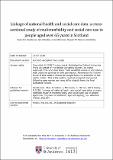Files in this item
Linkage of national health and social care data : a cross-sectional study of multimorbidity and social care use in people aged over 65 years in Scotland
Item metadata
| dc.contributor.author | Henderson, David A.G. | |
| dc.contributor.author | Atherton, Iain | |
| dc.contributor.author | McCowan, Colin | |
| dc.contributor.author | Mercer, Stewart W. | |
| dc.contributor.author | Bailey, Nick | |
| dc.date.accessioned | 2021-07-15T23:39:22Z | |
| dc.date.available | 2021-07-15T23:39:22Z | |
| dc.date.issued | 2020-07-16 | |
| dc.identifier | 268010244 | |
| dc.identifier | cc97bd44-ad2e-46e4-a429-4ebcc5868ef5 | |
| dc.identifier | 85099721429 | |
| dc.identifier | 000646848300031 | |
| dc.identifier.citation | Henderson , D A G , Atherton , I , McCowan , C , Mercer , S W & Bailey , N 2020 , ' Linkage of national health and social care data : a cross-sectional study of multimorbidity and social care use in people aged over 65 years in Scotland ' , Age and Ageing , vol. Advance Article , afaa134 . https://doi.org/10.1093/ageing/afaa134 | en |
| dc.identifier.issn | 1468-2834 | |
| dc.identifier.other | ORCID: /0000-0002-9466-833X/work/78205114 | |
| dc.identifier.uri | https://hdl.handle.net/10023/23583 | |
| dc.description | Funding: This work was supported by the Scottish Government (SG) and the Economic and Social Research Council (ESRC) (Grant numbers: ES/S007407/1 & ES/L011921/1). | en |
| dc.description.abstract | Background: little is known about the relationship between multimorbidity and social care use (also known as long-term care). The aim of this study was to assess the relationship between receipt of formal social care services and multimorbidity. Methods: this retrospective data linkage, observational study included all individuals over the age of 65 in the population of Scotland in financial years 2014–15 and 2015–16 (n = 975,265). The main outcome was receipt of social care measured by presence in the Scottish Social Care Survey. Logistic regression models were used to assess the influence of multimorbidity, age, sex and socioeconomic position on the outcome reporting average marginal effects (AME). Findings: 93.3% of those receiving social care had multimorbidity, 16.2% of those with multimorbidity received social care compared with 3.7% of those without. The strongest magnitudes of AME for receiving social care were seen for age and multimorbidity (respectively, 50 and 18% increased probability comparing oldest to youngest and most severe multimorbidity to none). A 5.5% increased probability of receiving social care was observed for the most-deprived compared with the least-deprived. Interpretation: higher levels of social care receipt are observed in those with increasing age, severe multimorbidity and living in more deprived areas. Multimorbidity does not fully moderate the relationship between social care receipt and either age or deprivation. | |
| dc.format.extent | 7 | |
| dc.format.extent | 746810 | |
| dc.language.iso | eng | |
| dc.relation.ispartof | Age and Ageing | en |
| dc.subject | Social care | en |
| dc.subject | Multimorbidity | en |
| dc.subject | Data linkage | en |
| dc.subject | Long-term care | en |
| dc.subject | Older people | en |
| dc.subject | HV Social pathology. Social and public welfare | en |
| dc.subject | QA75 Electronic computers. Computer science | en |
| dc.subject | RA Public aspects of medicine | en |
| dc.subject | 3rd-DAS | en |
| dc.subject.lcc | HV | en |
| dc.subject.lcc | QA75 | en |
| dc.subject.lcc | RA | en |
| dc.title | Linkage of national health and social care data : a cross-sectional study of multimorbidity and social care use in people aged over 65 years in Scotland | en |
| dc.type | Journal article | en |
| dc.contributor.institution | University of St Andrews. School of Medicine | en |
| dc.contributor.institution | University of St Andrews. Sir James Mackenzie Institute for Early Diagnosis | en |
| dc.contributor.institution | University of St Andrews. Population and Behavioural Science Division | en |
| dc.identifier.doi | https://doi.org/10.1093/ageing/afaa134 | |
| dc.description.status | Peer reviewed | en |
| dc.date.embargoedUntil | 2021-07-16 |
This item appears in the following Collection(s)
Items in the St Andrews Research Repository are protected by copyright, with all rights reserved, unless otherwise indicated.

